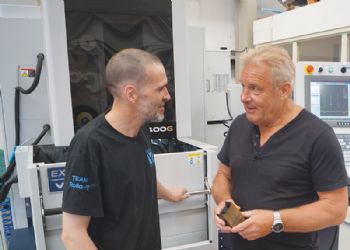
Most engineering companies forming thin sheet-metal material will usually rely on the capabilities of CNC press brakes, which in turn rely on the quality of the tooling used.
Rolla-V Ltd, a leading UK manufacturer of press-brake tools, recently enhanced its production capability with the installation of a new CNC wire EDM machine.
Shortly after Kevin Marklew established his Halesowen-based precision engineering company with the aim of producing high-quality press brake tooling, he had the opportunity to purchase the patent for the company’s now world-renowned Rolla-V tool.
He said: “A British inventor came up with the idea for this type of press brake tool, but we had to develop it so that it functioned correctly.
“This was a slow process initially, because the machine shop was busy making standard tools for a world-wide customer base that was using Amada, Trumpf, Bystronic, Safan, LVD Adira, Durma and Bakal press brakes.
“We made a sample Rolla-V tool at the start of 1994, which coincided with the Channel Tunnel project, where there was a need to eliminate sharp edges from rail-side fabrications, because they could cause injury. The project director wanted a round cap on all box sections, of which there was miles, but the company contracted to supply this had failed to deliver.

“The sample tool I had made that would form the necessary profile was relatively short, but I knew it could be made longer and produce suitable sections in one hit.
“I subsequently made a tool that produced the semi-circular cap required, and this led to a rapid growth in the business, as word of the capabilities of Rolla-V press brake tooling spread through various industry sectors.”
Meeting demand
Rolla-V tooling, which is now part of the company’s standard range, is made in 500mm lengths and ‘sectioned’ as required (it can also be ganged together to form longer parts).
However, as the popularity of this tooling grew, meeting demand was problematic. Mr Marklew says: “The workload on the shopfloor to deliver the quantity of orders we were receiving was taking its toll, so we invested in a Mazak CNC machine, a grinder and — most recently — an Excetek wire-cut EDM machine.
“This equipment allowed us to refine the product and make it better.”
With 17 staff working ‘flat out’ to meet production demands, the new EDM machine — an Excetek V400G CNC from Warwick Machine Tools (
www.warwickmachinetools.co.uk) — had to ‘slot straight in’ and provide an immediate benefit, which it did.
“To efficiently create the different lengths of Rolla-V tooling sections, we produce full-length components, assemble them as a finished tool and then cut across the tool at the required length.
“We had been doing this on a bandsaw, but the finish was nowhere near the level we wanted to present to customers, so we had to apply various manually intensive finishing operations.”
Now, the long sections of press brake tools are simply cut into the appropriate length by the Excetek V400G EDM machine.
This has X and Y travels of 400 and 350mm respectively; it can also accommodate large workpieces — up to 750 x 550 x 215mm and weighing up to 500kg, all within a compact footprint.

Like all standard Excetek wire-cut EDM machines, the V400G features a C-frame ‘honeycomb’ structure (designed using FEA software) that provides high levels of accuracy and minimises any thermal influence.
The machine also features an automatic wire-feed and threading system (AWT) that supports continuous unmanned operation (the AWT offers the ability to thread the wire at the point of the breakage, while an automated annealing system straightens the wire so that it can be threaded at the break point — during machining — with almost 100% reliability and without the need to return to the start position).
Submerged wire threading is also possible, removing the need to drain and refill the tank, and a water-jet assist system is available for automatic wire feed on tall workpieces.
Rolla-V patented press-brake tooling allows the receiving part of the tool to rotate about a pre-determined axis, allowing the tool to move with the sheet material.
This tooling offers numerous advantages, including: a much tighter formed bend radius (typically half the radius achieved with conventional tooling); and minimal material deformation (which improves the material’s fatigue strength and allows bends to be formed much closer to any holes or other features without distortion).
Furthermore, because the rotation of the tool does not ‘drag’ the sheet material across its surface (like a conventional forming process) coated materials can be used without risk of marking, as can uncoated materials such as ‘brushed’ stainless without a protective film.
Mr Marklew says that this final point is important with regard to material cross-contamination. “Customers don’t like using the same ‘conventional tools’ on stainless steel as they do on ferrous steel or aluminium, because the tool can ‘pick up’ from one material, and particles can be deposited in the next sheet. Rolla-V eliminates this concern.”